These Are the Iconic New Orleans Dishes Everyone Should Try at Least Once

When visitors start planning trips around famous New Orleans foods, you know a city’s culinary scene is hot. From traditional gumbo steeped with Cajun influences and a towering muffuletta to newer Vietnamese-Creole fusion dishes that reflect the current diversity of "Nawlins," there’s much to choose from in this foodie paradise.
Chef and NOLA native, Ashley Jonique, tells OprahMag.com that the diversity of the New Orleans culinary scene—which blends French, African, and Spanish cultures, to name a few—combines the seafood and vegetables of the region with influences from the various communities that call New Orleans home.
"We have a slogan, ‘Do Whatcha Wanna,’ so when it comes to cooking, we basically do what we want all the time," she says.
Now, there are gumbo pizzas, jambalaya spring rolls, and rich, filet mignon-based Yaka mein soups.
Still, the classic elements of local cuisine remain, which include what Jonique calls "the holy trinity" of fresh produce (bell peppers, onions, and celery) and staples from enduring institutions, like the pillowy pastries at Cafe Beignet and the buttery, grilled oysters at Drago's.
Here's a list of all the restaurants and traditional New Orleans food you don't want to miss out on—whether you're headed to the Big Easy to partake in time-honored Mardi Gras traditions on February 16, or just bookmarking for later—leave the beads at home and bring your appetite.
1. King Cake at Laurel Street Bakery
King Cake is a braided sweet bread shaped into a circle and covered with icing and colored sprinkles—typically green, representing faith, purple for justice, and gold for power. The treat is customarily enjoyed from Three Kings Day, also known as Epiphany on January 6, leading up to Mardi Gras and the start of the Lenten season, when people tend to abstain from such indulgences.

Laurel Street Bakery makes it from scratch with brioche dough that's hand-braided with cinnamon and sugar, and filled with cream cheese, apple, strawberry, or praline. Owner Hillary Guttman prides herself on creating a space that organically gathers the community. After Hurricane Katrina, the bakery was among the first places residents could go for a cup of coffee and sense of belonging, she says. That spirit of conviviality is precisely why Laurel Street Bakery has become a special place for New Orleanians. Civic leaders are regular patrons and the Mayor's Office even used the bakery as a location for a recent video shoot.
2. Death by Gumbo at Restaurant R’evolution

This is not your typical gumbo, which has a thick filé stock with seafood and or meat, and a Louisianian “Holy Trinity” of vegetables: bell peppers, celery, and onions. Rather, it’s a modern and elevated take on the traditional stew by chefs John Folse and Rick Tramonto. John Folse is an expert on Louisiana cuisine and the author of several books, most notably The Encyclopedia of Cajun & Creole Cuisine and The Evolution of Cajun & Creole Cuisine. Their version contains a roasted quail stuffed with andouille sausage, oysters, and filé rice. Eater calls it "a deconstructed gumbo dish to die for.”
3. Beignets at Cafe Beignet

While the crowds and the line of tourists go to Café Du Monde, the locals know to head to Cafe Beignet for this signature New Orleans sweet. With three locations across the city, it cuts down the wait time significantly for this pastry doughnut hybrid dusted with powdered sugar. The French and Acadians brought beignets to the region in the 18th century, but New Orleans helped to give the powdery delight the recognition that it receives today.
4. Poor Boy at Parkway Bakery and Tavern
Parkway has been around for over a century, since 1911 to be exact. Legend has it that the name poor boy, also referred to as po’ boy, comes from the Great Depression era when a sandwich was created to be given free of charge to transit strikers. Folks have been clamoring for Parkway’s poor boys ever since.
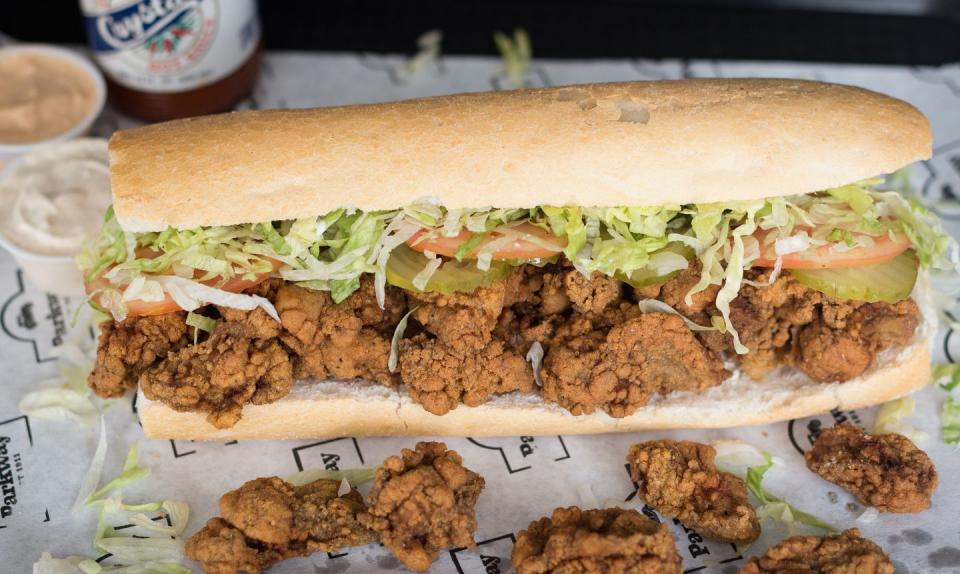
While they can contain a variety of fillings–typically seafood like oysters, shrimp, or catfish–the bread is really what makes them distinctive. Traditionally, a loaf of French bread has tapered ends, but the loaf for poor boys is rectangular end to end to maximize stuffing capacity.
5. Bananas Foster at Brennan's
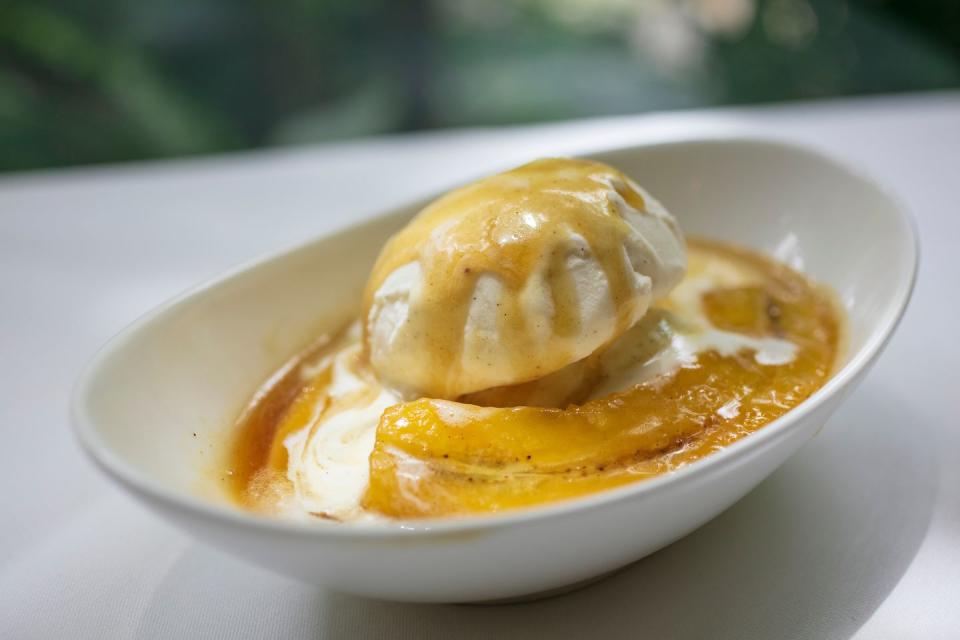
Being an enterprising restaurant owner, Owen Brennan encouraged Paul Blangé, his chef, to invent a dish with bananas as the main attraction, in 1951. The dish was named after Richard Foster, the former chairman of the New Orleans Crime Commission and friend of Owen Brennan. In this iconic dish, bananas are flambéed tableside with brown sugar, butter, cinnamon, rum and served with New Orleans Ice Cream Co. vanilla bean ice cream. Today, Bananas Foster is the most ordered dish on the menu.
6. Pimento Cheese Grits at High Hat Café

Located on “Pimento Cheese Row” the bar is set high for this dish adapted from the owner's family recipe. Allison Richard, chef of High Hat Café says, “The real game changer is grating your own cheese.” She adds, "Fresh garlic and Hellmann's mayonnaise—the only kind I use—round it out."
7. Pralines at Leah’s Pralines
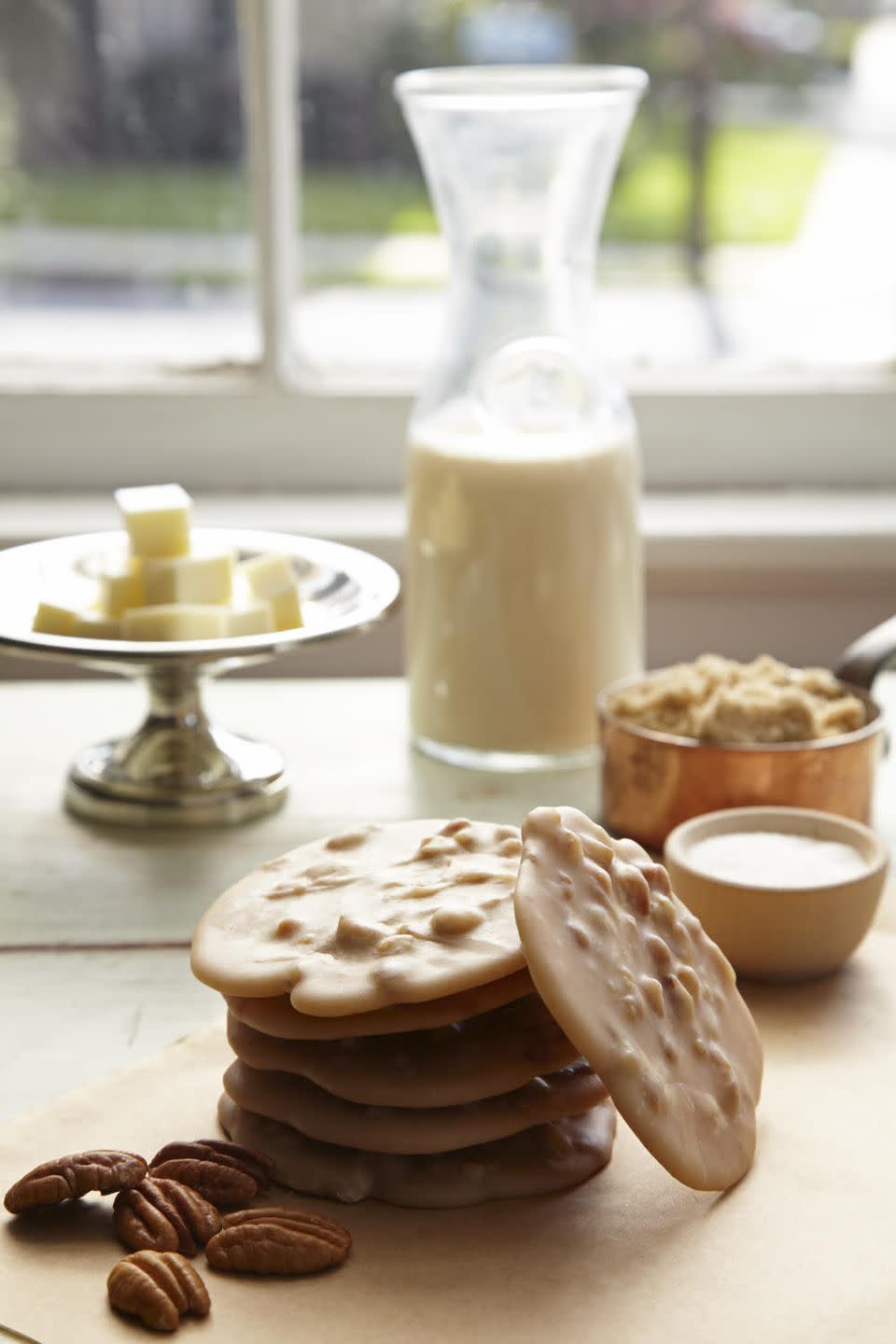
A family owned and operated business since 1944, Leah’s Pralines uses locally sourced ingredients such as Alabama pecans and Louisiana sugar. Each day their Creole confections are made small batch to ensure freshness and quality. Similar to other local treats, the New Orleans praline has origins that can be traced back to its French heritage. New Orleans confectioners adjusted the traditional recipe to include almonds and cream.
8. Charbroiled Oysters at Drago’s
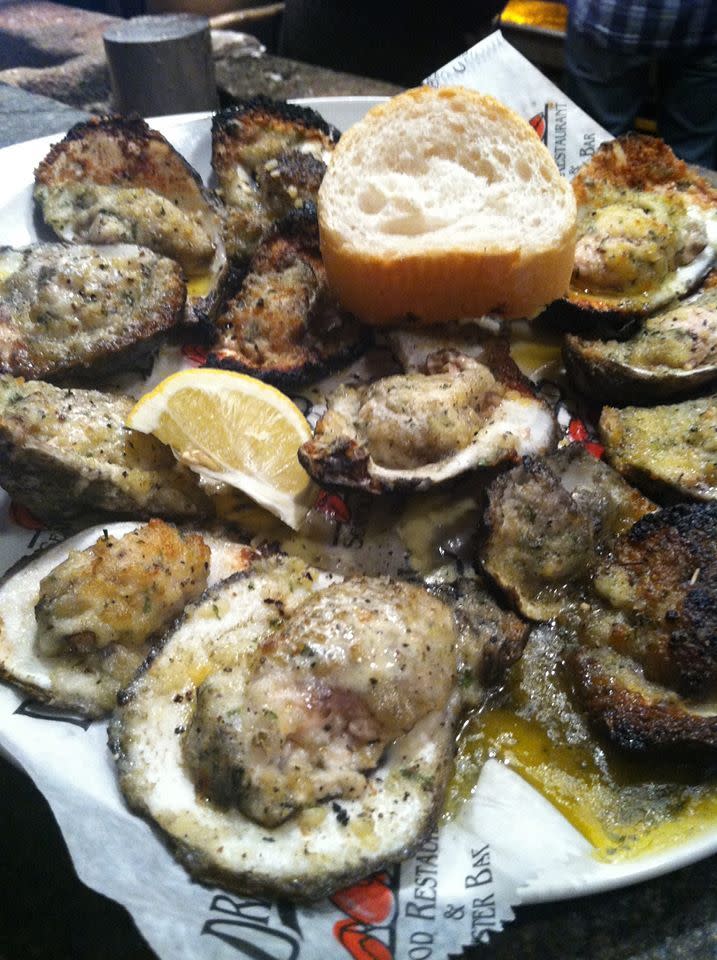
It’s hard to argue with oysters brushed with garlic, butter, herbs, and topped with Parmesan and Romano cheese. Drago’s pride themselves on being a part of the immigrant oyster farming legacy in Louisiana for generations. They can serve over 900 dozen Charbroiled Oysters on a good day.
9. Mr. B's Barbequed Shrimp at Mr. B’s Bistro

Mr. B’s Bistro has been a French Quarter staple since 1979, blending both Creole and Cajun cuisines. New Orleans barbequed shrimp is not cooked on a grill. Rather, it is sautéed with Worcestershire, lots of butter, garlic, and black pepper. Cindy Brennan, co-owner and managing partner, comes from a family with deep roots in the New Orleans restaurant industry. One of her most notable relatives is Ella Brennan, who ran the iconic Commander's Palace (another favorite spot for tourists) and won the 2009 James Beard Foundation Lifetime Achievement Award.
10. Muffuletta at Central Grocery
A muffuletta is a round sesame bread from Sicily. Italian immigrants in New Orleans turned it into a beloved sandwich with marinated olive salad, salami, ham, Swiss cheese, provolone, and mortadella on the namesake round muffuletta bread. Central Grocery is an Italian grocery store that dates to 1906 and owner Salvatore Lupo is credited with creating the New Orleans favorite, which has since spread around the country. In Lupo's case, having the best ingredients at your fingertips certainly helps. They use locally baked bread, in-house sliced meats, and an Italian olive salad that's a family recipe.
11. Café Brûlot at Galatoire's
Galatoire's has been around since 1905. Looking for an entertaining way to end your meal? Then the Café Brûlot, which includes orange, lemon, cloves, cinnamon, brandy, Grand Marnier, and hot French roast coffee, is a must. Bonus: This boozy beverage is served tableside with a flame show.
12. Fried Chicken at Willie Mae's Scotch House
A Treme neighborhood staple, Willie Mae’s has been open since 1957. Willie Mae Seaton was the original author of their popular secret fried chicken recipe, and now the torch has been passed on to her great-granddaughter, Kerry. The restaurant has received a James Beard award and was named “America’s Best Fried Chicken” by the Travel Channel. This neighborhood eatery has become a national phenomenon and with good reason. Eater’s Nick Solares describes the chicken as “life-changing."
13. Glazed Pork Belly Bowl at MoPho
Chef Michael Gulotta, a New Orleans native, took inspiration from his Louisiana upbringing and combined it with Vietnamese influences that have sprung up in the city over the years. This unique confluence of cuisines has earned Gulotta recognition from local, New Orleans Magazine, and national publications, Bon Appétit and Food & Wine. One of the most popular dishes is the Glazed Pork Belly Bowl with hot smoked shoulder, spiced peanut, cracklin, and cured strawberries. It's served over either vermicelli noodles or warm coconut rice.
14. Red Beans and Rice at Neyow’s

Neyow’s is a Creole favorite. Owned by Tanya and Timothy Dubuclet, the restaurant’s recipes were handed down from their grandmothers. They like to say that “Neyow’s is one of the most recommended restaurants by Uber drivers and hotel concierges,” a.k.a. those in the know. Their red beans and rice is a Monday special that has become a weekly tradition amongst locals and is served with a choice of fried chicken, grilled pork chops, or hot sausage.
15. Spicy Shrimp Phở at Lilly's Café
Just like any other city, the culinary scene in New Orleans has grown to reflect its residents. Lilly’s Café is a Vietnamese restaurant that calls the Lower Garden District its home. The spicy shrimp phở is a nod to the deep seafood heritage of the city, with its ever changing and expanding food culture.
16. Golden Curry at Small Mart
Small Mart is a neighborhood gem in the French Quarter. This intimate spot, popular among vegetarians, vegans, and omnivores alike, recently expanded into a new space from their original convenience store and takeout location. The consistent crowd pleaser among New Orleanians is Small Mart’s golden curry, made with chickpeas, potatoes, and many more healthy goodies.

17. Snoball (shaved ice) at Hansen’s Sno-Bliz
If you want a frozen food experience with a sweet history, head over to Hansen’s Sno-Bliz. Husband and wife team, Ernest and Mary Hansen, began their “snoball” business in 1939. Ernest was the inventor—he received a U.S. Patent for his ice-shaving machine—and his wife, Mary was the savvy businesswoman with a line of syrups.
Ernest’s fluffy ice was a welcomed reprieve during the notoriously hot summers in New Orleans. 80 years later, their granddaughter is running the show with frozen treats that were named an American Classic by the James Beard Foundation in 2014.
18. Breakfast Pizza at Katie's
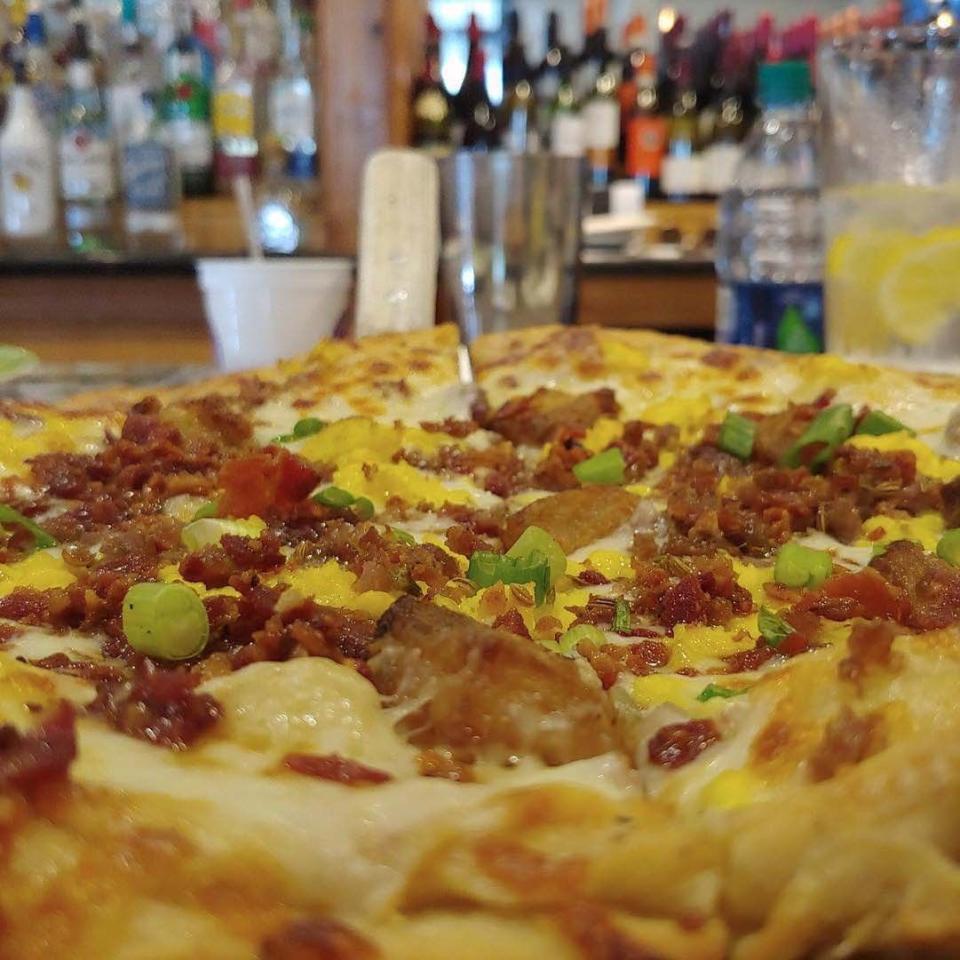
Who doesn’t love breakfast and pizza? Katie’s breakfast pizza is topped with hash browns, eggs, sausage, bacon, and green onions. It's also covered in St. Louis style creamy Provel cheese—perfect for making those beautiful strands for an Instagram moment. What ties all the flavors together is the rich garlic butter cream sauce. It’s a hearty way to start your day or perhaps recover from a night out on Bourbon Street.
19. Jambalaya at the New Orleans School of Cooking
If you want to bring some Cajun magic back from your New Orleans trip, you don't have to smuggle home crawfish in your carry-on bag. The New Orleans School of Cooking offers several instructional options for people looking to learn how to make local staples such as barbecue shrimp and grits, gumbo, and jambalaya.
The jambalaya recipe in particular has been spread far and wide by publications like Cooks.com. It uses chicken, garlic, sausage, long grain rice, and their special blend of low sodium Creole seasoning called Joe's Stuff (named for the school's founder, Joe Chan).
In 2018, their courses were ranked the no. 2 food experience in the world by Trip Advisor.
20. Crawfish at Boil Seafood House
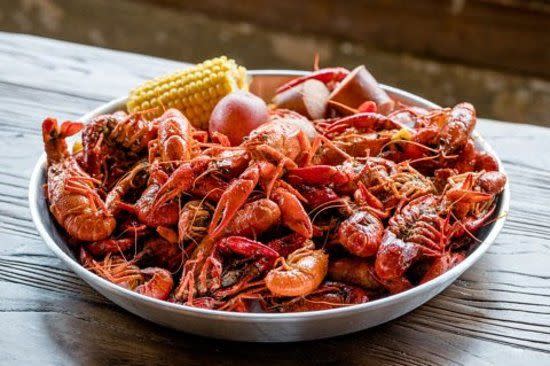
When crawfish season hits in New Orleans, locals and visitors alike scramble to find the nearest boil. Crawfish is often served simply, with corn and or sausage, but some restaurants give more options.
At Boil Seafood House on Magazine Street, guests first pick their catch, which is often crawfish but can be anything from king crab legs to clams, and a flavor, and finally a heat level. Hardcore crawfish heads can order some of their seafood buckets, including The Cajun Classic, The Taste of New Orleans, and The Feast, all of which offer a pound of crawfish and all kinds of other crustaceous goodies.
21. Biscuits at Biscuits and Buns
At some point, you'll need a break from nonstop seafood and hearty po' boys, and there's no better palette cleanse than a soft, warm breakfast biscuit. The restaurant itself is hard to miss, as it's located in a distinctive shotgun house.
The biscuits at Biscuits and Buns are exceptionally versatile. They're served a myriad of ways—as a side dish with pecan butter or preserves, beside their barbecue shrimp and grits, or even as the basis for a chicken tender sandwich with honey sriracha.
For more ways to live your best life plus all things Oprah, sign up for our newsletter!
You Might Also Like

